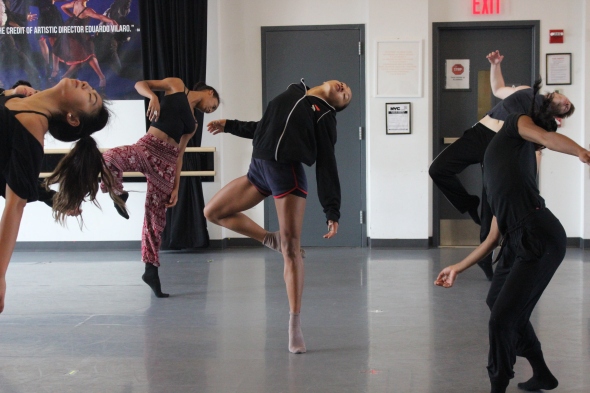Instituto Coreográfico 2017: Q&A with Carlos Pons Guerra, Part 1
Posted: October 5, 2017 Filed under: Behind-the-Scenes @ BH, Dancers, Instituto Coreografico, Performances | Tags: Ballet Hispanico, Carlos Pons Guerra, choreographer, dance, Instituto Coreografico Leave a commentFor the latest installment of Instituto Coreográfico, Ballet Hispanico’s choreography lab for Latino artists, we welcome Spanish choreographer Carlos Pons Guerra to our studios to work with our dancers. We caught up with him recently for a reflection on his experience, which will culminate tonight in a public showing. Here’s Part 1 of what he had to say on this collaborative process:

Carlos in process with the dancers. (c) Johan Rivera
What has your approach been for working with the Ballet Hispánico dancers?
We have been having a great and productive time in the studio with Ballet Hispánico! It has been a very interesting dialogue. For the first couple of days, I taught the dancers sequences of my movement, sequences that to me represented the raw essence of the piece. That way they also got to know me a little. I then would give the dancers assignments to do with my movement, which I call ‘dramatic tasks’ as they have a certain sense of narrative. For instance, in couples, I asked them to perform my sequence but that any moment, one of their body parts had to totally give up dancing–so we created duets that had an idea of giving up, of abandon, but also of support. It’s a really interesting two-way approach, where I give information and the dancers constantly feed back. We have also spent time researching telenovelas together–Latino soap operas have really influenced the aesthetic of the piece–and exchanging observations on the heightened sense of drama and performance you find in them.
“Being here now, and being able to explore my Hispanic themes with dancers who are so committed to them, who get you from the start, and who can really enrich your exploration through their own heritage and cultural experiences–wow, it’s super special.”
Before you got to meet them, what was your perception of the Ballet Hispánico Company?
I first saw Ballet Hispánico at the International Ballet Festival of Havana in 2014. I fell in love then, and that hasn’t changed–except perhaps that I am more full of #BHamor than ever! My perception then was that they were beautiful dancers with great skill, technique, and articulate bodies, but above that, a very honest and explosive sense of projection and presence. Another thing that really struck me was their commitment and passion to exploring and celebrating Latino culture, which is the main thing that made me start choreographing six years ago. So being here now, and being able to explore my Hispanic themes with dancers who are so committed to them, who get you from the start, and who can really enrich your exploration through their own heritage and cultural experiences–wow, it’s super special.

L to R: Shelby Colona, Gabrielle Sprauve, Jenna Marie, Nick Fearon, Dandara Veiga (c) Johan Rivera
Is there anything that has surprised you so far about the process, about our dancers, or just the experience in general?
Something really surprising for me, and which is really driving the process, is this love and need to dance. It may sound funny as I work only in dance, but in some other contexts, I have sensed a certain kind of lethargy. But Ballet Hispánico dancers need to move, and they do it beautifully and with such energy and speed. It’s contagious and it makes my job happen much faster and with drive. I’m very happy because the work is developing into something very dynamic and it feels very alive.
A key element is the drama. My work is generally a bit comical, very physical but also heavily character based. The dancers have a lot of personality and are very generous in offering it to the choreography—they’ve understood me really quickly and with hardly any direction and they are giving me full telenovela realness! I watch some sections and I feel I’m in a scene from La Usurpadora or Maria la del Barrio—it’s amazing and I love it!

Carlos Pons Guerra working with Eila Valls and Jared Bogart (c) Johan Rivera
What is inspiring the movement you’re working on right now at Ballet Hispánico?
There are two main sources of inspiration for this work: 1) Federico Garcia Lorca’s The House of Bernarda Alba and 2) the genre of Latin soap operas, telenovelas. The overall themes of these are the fight against repression, unfair gender impositions, the need to express oneself, and the tensions and aggression that can happen when people are not allowed to fully realize their identity and voice. Light stuff! But we are trying to make a comedy out of it, so we can hopefully both entertain people while making them reflect.
“Ballet Hispánico dancers need to move, and they do it beautifully and with such energy and speed.”
The movement we are developing has the heightened sense of melodrama, the absurdity, the over-the-top quality and stylized character of the telenovela, married to marching, processional-like movements of strict imposed tradition, a feeling of weight and boredom, sibling tension, and an internal conflict to release oneself, which are what I took from Lorca’s play.
Thanks for chatting, Carlos! New York-area fans can come see a sneak-peek showing of Carlos’ work-in-progress tonight, October 5th, at Ballet Hispánico at 7:00 pm. RSVP: bit.ly/2xOEOFN
